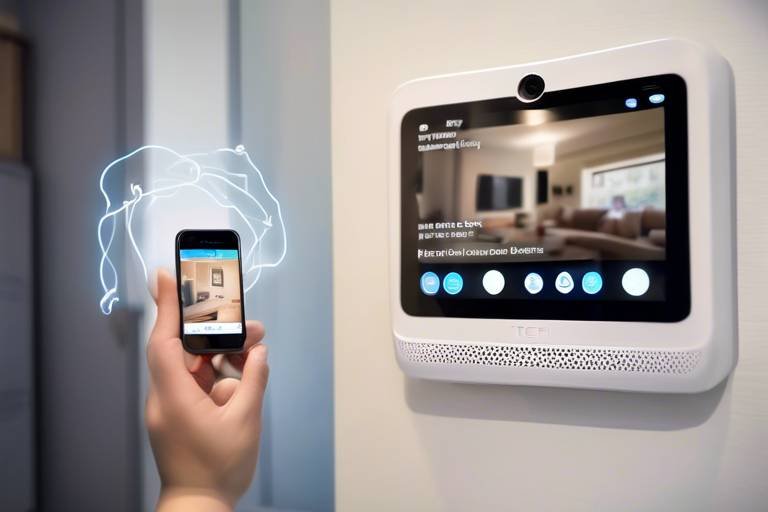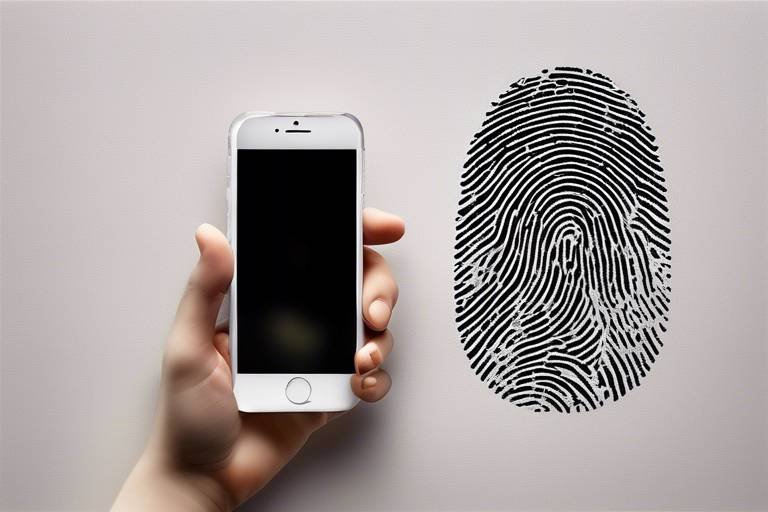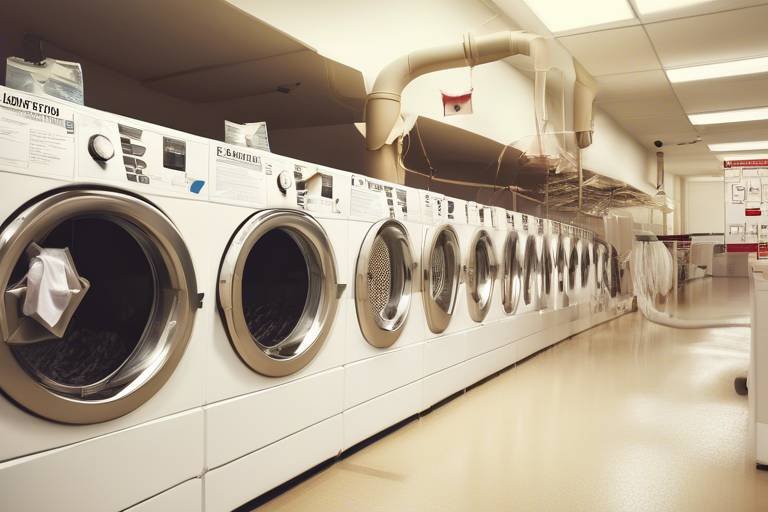Tech Safety: How Safe Are Smart Home Devices?
In today's fast-paced world, smart home devices have become an integral part of our daily lives. From smart speakers that play our favorite tunes to security cameras that keep an eye on our homes, these gadgets promise convenience and enhanced lifestyle. However, as we embrace this technology, a burning question looms: how safe are these devices? The convenience of controlling our homes with a simple voice command or a tap on our smartphones can sometimes overshadow the potential risks associated with these interconnected devices.
As we dive deeper into the realm of smart home technology, it’s essential to understand not just the benefits but also the vulnerabilities that come with them. Imagine your home as a fortress; every door and window must be secured to keep intruders at bay. Similarly, smart home devices can serve as entry points for cybercriminals if not adequately protected. This article explores the safety concerns surrounding smart home devices, examining vulnerabilities, best practices for protection, and the implications of their widespread use in modern households.
Smart home devices encompass a wide range of technologies, including but not limited to smart thermostats, smart lighting, and home assistants. These devices are designed to communicate with each other and often connect to the internet, allowing users to control them remotely. Understanding how these devices function and their interconnectedness is crucial for evaluating their safety and potential risks. For instance, a smart camera linked to your home network can provide real-time surveillance, but if compromised, it could also allow hackers access to your entire network.
Despite their advantages, smart home devices often harbor significant security flaws that can be exploited by hackers. Identifying these vulnerabilities is the first step in taking preventive measures to safeguard your privacy and data. One of the most glaring risks stems from weak passwords. Many users opt for default passwords or simple phrases, making it easy for cybercriminals to gain unauthorized access. Implementing strong, unique passwords can dramatically reduce this risk.
Weak passwords are akin to leaving your front door wide open. To enhance security, users should create passwords that include a mix of letters, numbers, and special characters. It’s also recommended to change passwords regularly and avoid using the same password across multiple devices. A strong password is your first line of defense against potential breaches.
To further bolster your security, consider enabling two-factor authentication (2FA). This method adds an extra layer of security by requiring users to verify their identity through a second method, such as a text message or authentication app. Think of it as a double-lock system on your door; even if someone has your key (password), they still can't enter without the second verification.
Another essential practice is keeping your device firmware up to date. Regular software updates are crucial for patching security vulnerabilities. Manufacturers often release updates to fix flaws that could be exploited by hackers. By ensuring your devices are updated, you protect them against newly discovered threats, much like reinforcing your home's security with the latest technology.
Smart home devices often collect personal data, raising significant concerns about privacy. Understanding data usage policies is vital for users to protect their information. Many devices gather data on your habits and preferences, which can be valuable to third parties. Always read the privacy policies before purchasing or using a smart device, and consider opting out of data collection where possible.
Implementing best practices can significantly enhance the security of your smart home devices. Users should be proactive in managing their devices to minimize risks. One fundamental aspect is ensuring that your home network is secure. Using a strong Wi-Fi password and enabling network encryption can help protect connected devices from unauthorized access.
Securing your home network is akin to building a strong wall around your fortress. Make sure to change the default settings of your router and use a strong password. Enabling WPA3 encryption can also provide an additional layer of security, making it harder for intruders to breach your network.
Regularly reviewing and managing connected devices is essential. Ensure that only necessary devices are linked to your network, reducing potential entry points for cybercriminals. Unused devices should be disconnected, much like closing off unused rooms in your home to limit access.
- Are smart home devices safe to use? - While they offer convenience, smart home devices can be vulnerable to hacking if not properly secured.
- What should I do if my device is hacked? - Disconnect it from your network, change passwords, and contact customer support for assistance.
- How can I improve the security of my smart home? - Use strong passwords, enable two-factor authentication, and keep devices updated.

Understanding Smart Home Devices
Smart home devices are revolutionizing the way we interact with our living spaces. Imagine walking into your home and having the lights automatically adjust to your preferred brightness, or your coffee maker brewing a fresh cup just as you wake up. These devices range from smart speakers and thermostats to security cameras and smart locks, all designed to make our lives more convenient and efficient. However, with this convenience comes a set of challenges, particularly regarding safety and security.
At their core, smart home devices are interconnected technologies that communicate over the internet, forming what is often referred to as the Internet of Things (IoT). This means that they can be controlled remotely through smartphones, tablets, or even voice commands. But have you ever stopped to think about what this interconnectedness means for your privacy and security? Each device connected to your home network can potentially serve as a gateway for cybercriminals, which is why understanding their functionalities is crucial.
To give you a clearer picture, here’s a brief overview of some common types of smart home devices:
- Smart Speakers: These devices can play music, answer questions, and control other smart devices through voice commands.
- Smart Thermostats: They learn your heating and cooling preferences over time, optimizing energy use and saving you money.
- Smart Security Cameras: These provide real-time monitoring of your home and can send alerts directly to your phone.
- Smart Locks: They allow you to lock and unlock your doors remotely, providing enhanced security and convenience.
While these devices can make our lives easier, they also raise important questions about safety. For instance, how secure is the data that these devices collect? What happens if a hacker gains access to your smart lock or security camera? Understanding how these devices operate and the potential risks involved is the first step in ensuring your home remains a safe haven.
Moreover, the integration of these devices into our daily lives means that we need to be more vigilant than ever. As we embrace technology, it’s essential to equip ourselves with knowledge about the security features of these devices. This includes being aware of how they connect to your home network, the data they collect, and the measures you can take to protect your privacy.
In conclusion, while smart home devices offer a myriad of benefits that can enhance our quality of life, they also come with inherent risks. By being informed and proactive, we can enjoy the conveniences of modern technology without compromising our safety. So, are you ready to dive deeper into the world of smart home devices and learn how to protect your digital sanctuary?
Here are some common questions regarding smart home devices and their safety:
- What are the most common security risks associated with smart home devices? Common risks include weak passwords, outdated software, and unsecured networks.
- How can I improve the security of my smart home devices? Implementing strong passwords, enabling two-factor authentication, and regularly updating device firmware can significantly enhance security.
- Are all smart home devices equally vulnerable? No, the level of vulnerability can vary based on the manufacturer, device type, and security features implemented.

Common Security Vulnerabilities
In our increasingly connected world, smart home devices have become a staple in many households, offering convenience and automation that make life easier. However, with this convenience comes a host of security vulnerabilities that can leave users exposed to cyber threats. It's essential to recognize these vulnerabilities to take proactive steps toward safeguarding your home and personal data. One of the most significant issues revolves around the security flaws inherent in these devices. Whether it's a smart thermostat, a security camera, or a voice assistant, each device can serve as a potential entry point for hackers if not adequately protected.
One of the primary vulnerabilities is the reliance on weak passwords. Many users still opt for default passwords or simple combinations that are easy to guess. This oversight can lead to unauthorized access, allowing intruders to manipulate devices or even breach the home network. To illustrate this point, consider a scenario where a hacker gains access to a smart door lock. With the right knowledge, they could unlock the door remotely, posing a serious security risk to the occupants. Therefore, creating strong, unique passwords for each device is a crucial first step in enhancing security.
Implementing robust password protection is vital. A strong password typically includes a mix of uppercase and lowercase letters, numbers, and special characters. It should be at least 12 characters long and avoid easily guessable information such as birthdays or names. Here’s a quick checklist to help you create a strong password:
- Use a combination of letters, numbers, and symbols.
- Avoid using personal information.
- Change passwords regularly.
- Consider using a password manager for added security.
Another layer of protection comes from two-factor authentication (2FA). This method requires users to provide two forms of identification before gaining access to their devices. For example, after entering a password, users might receive a text message with a verification code that they must input to complete the login process. This additional step can significantly reduce the likelihood of unauthorized access, as it makes it much harder for hackers to gain entry even if they manage to obtain a password.
Keeping device firmware up to date is another critical aspect of maintaining security. Manufacturers often release updates to patch known vulnerabilities and enhance functionality. Neglecting to install these updates can leave devices susceptible to attacks. For instance, a security camera with outdated software may have a known exploit that hackers can easily leverage. Setting devices to update automatically can help ensure you’re always protected against the latest threats.
Furthermore, users should be aware of the data privacy concerns that arise from the use of smart home devices. Many of these devices collect personal information, which can be shared with third parties or even fall into the hands of cybercriminals. Understanding the data usage policies of each device is vital for users who want to protect their personal information. Always check the privacy settings and opt-out of data sharing wherever possible.
In summary, while smart home devices provide incredible convenience, they also come with inherent security vulnerabilities. By understanding these risks and taking proactive measures—such as implementing strong passwords, enabling two-factor authentication, regularly updating software, and being mindful of data privacy—users can significantly enhance their home security and protect their personal information from potential threats.
Q1: Are smart home devices really vulnerable to hacking?
Yes, smart home devices can be vulnerable to hacking if proper security measures are not taken. Weak passwords and outdated software are common entry points for cybercriminals.
Q2: How can I protect my smart home devices?
To protect your devices, use strong, unique passwords, enable two-factor authentication, regularly update software, and secure your home network.
Q3: What should I do if I suspect my smart home device has been hacked?
If you suspect a breach, immediately change your passwords, disconnect the device from the network, and consider resetting it to factory settings. You may also want to consult a cybersecurity expert.

Password Protection
This article explores the safety concerns surrounding smart home devices, examining vulnerabilities, best practices for protection, and the implications of their widespread use in modern households.
Smart home devices encompass a range of technologies, from smart speakers to security cameras. Understanding their functionalities and interconnectedness is crucial for evaluating their safety and potential risks.
Smart home devices often have security flaws that can be exploited by hackers. Identifying these vulnerabilities helps users take preventive measures to safeguard their privacy and data.
When it comes to protecting your smart home devices, is your first line of defense. Think of your password as the key to your home. If it’s weak or easily guessed, you might as well leave the door wide open for anyone to stroll in. Unfortunately, many users still opt for simple passwords, such as "123456" or "password," which are akin to using a flimsy lock on a sturdy door. To truly enhance your security, you should consider the following:
- Create Strong Passwords: A strong password typically includes a mix of uppercase and lowercase letters, numbers, and special characters. Aim for at least 12-16 characters to make it harder for hackers to crack.
- Avoid Common Words: Steer clear of using easily guessable information, such as your name, birthday, or pet’s name. These can be easily found on social media or public records.
- Unique Passwords for Each Device: Using the same password across multiple devices is like using the same key for your house, car, and safe. If one is compromised, all are at risk.
Additionally, consider using a password manager. This handy tool can generate and store complex passwords for you, so you don’t have to remember them all. It's like having a personal vault for your keys, ensuring they are both secure and accessible only to you.
Two-factor authentication (2FA) is another essential step in securing your smart home devices. By requiring a second form of verification, such as a text message code or a fingerprint scan, you add an extra layer of security that makes it significantly harder for intruders to gain access. Imagine needing not just a key, but also a secret handshake to enter your home—this is what 2FA does for your devices.
Keeping device firmware up to date is crucial for patching security vulnerabilities. Regular updates are like having a security system that gets smarter over time, adapting to new threats. Many devices can be set to update automatically, so you don’t have to worry about forgetting. Just make sure to check your settings periodically to ensure everything is running smoothly.
Smart home devices often collect personal data, raising concerns about privacy. Understanding data usage policies is vital for users to protect their information.
Implementing best practices can enhance the security of smart home devices. Users should be proactive in managing their devices to minimize risks.
Securing the home network is fundamental. Using a strong Wi-Fi password and enabling network encryption can help protect connected devices from unauthorized access.
Regularly reviewing and managing connected devices ensures that only necessary devices are linked to the network, reducing potential entry points for cybercriminals.
- What is the best way to create a strong password?
The best way to create a strong password is to use a combination of letters (both uppercase and lowercase), numbers, and special characters. Aim for at least 12 characters and avoid using easily guessable information.
- How often should I change my passwords?
It’s recommended to change your passwords every 3 to 6 months, especially for critical accounts or devices that store sensitive information.
- What should I do if I suspect my device has been hacked?
If you suspect your device has been hacked, immediately change your passwords, enable two-factor authentication, and perform a factory reset on the device if necessary. Also, check for any unauthorized access to your accounts.

Two-Factor Authentication
This article explores the safety concerns surrounding smart home devices, examining vulnerabilities, best practices for protection, and the implications of their widespread use in modern households.
Smart home devices encompass a range of technologies, from smart speakers to security cameras. Understanding their functionalities and interconnectedness is crucial for evaluating their safety and potential risks.
Smart home devices often have security flaws that can be exploited by hackers. Identifying these vulnerabilities helps users take preventive measures to safeguard their privacy and data.
Weak passwords are a significant security risk for smart home devices. Implementing strong, unique passwords can dramatically reduce the likelihood of unauthorized access.
When it comes to securing your smart home devices, two-factor authentication (2FA) is like having a bouncer at the door of your digital home. It's an extra layer of security that requires not just a password but also a second form of verification to access your devices. Think of it this way: even if a hacker manages to snag your password, they still need that second piece of information to get in. This could be a text message sent to your phone, an email verification, or even a biometric scan like a fingerprint.
Implementing 2FA is relatively straightforward and can significantly enhance your security. Most smart home devices and apps now offer this feature, and enabling it is one of the smartest moves you can make. Here are a few key benefits:
- Increased Security: With two layers of protection, the chances of unauthorized access are greatly reduced.
- Real-Time Notifications: Many 2FA systems will alert you if someone tries to log in, giving you a chance to react quickly.
- Peace of Mind: Knowing that your devices have an added layer of security allows you to enjoy your smart home without constant worry.
However, it’s essential to choose your second factor wisely. SMS messages can be intercepted, so consider using an authentication app or a hardware token for better security. In this digital age, it's crucial to stay one step ahead of potential threats, and 2FA is a powerful tool in your arsenal.
Keeping device firmware up to date is essential for patching security vulnerabilities. Regular updates ensure devices are protected against newly discovered threats.
Smart home devices often collect personal data, raising concerns about privacy. Understanding data usage policies is vital for users to protect their information.
Implementing best practices can enhance the security of smart home devices. Users should be proactive in managing their devices to minimize risks.
Securing the home network is fundamental. Using a strong Wi-Fi password and enabling network encryption can help protect connected devices from unauthorized access.
Regularly reviewing and managing connected devices ensures that only necessary devices are linked to the network, reducing potential entry points for cybercriminals.
Q: What is two-factor authentication?
A: Two-factor authentication (2FA) is a security process that requires two different forms of identification to access an account or device, enhancing security significantly.
Q: How do I enable two-factor authentication on my smart devices?
A: You can enable 2FA in the settings of your smart device or app. Look for the security settings and follow the prompts to set it up.
Q: Are there any downsides to using two-factor authentication?
A: While 2FA greatly increases security, it can sometimes be inconvenient if you don't have access to your second factor, like your phone or email.
Q: Can I use two-factor authentication for all my smart home devices?
A: Most modern smart home devices support 2FA, but it’s essential to check the specific device or app to verify.

Regular Software Updates
This article explores the safety concerns surrounding smart home devices, examining vulnerabilities, best practices for protection, and the implications of their widespread use in modern households.
Smart home devices encompass a range of technologies, from smart speakers to security cameras. Understanding their functionalities and interconnectedness is crucial for evaluating their safety and potential risks.
Smart home devices often have security flaws that can be exploited by hackers. Identifying these vulnerabilities helps users take preventive measures to safeguard their privacy and data.
Weak passwords are a significant security risk for smart home devices. Implementing strong, unique passwords can dramatically reduce the likelihood of unauthorized access.
Two-factor authentication adds an extra layer of security, requiring users to verify their identity through a second method, making it harder for intruders to gain access.
In today’s fast-paced digital world, keeping your smart home devices updated is not just a good practice; it’s essential for maintaining security. Regular software updates are like a shield against potential threats, patching vulnerabilities that hackers might exploit. When manufacturers discover a security flaw, they typically release an update to fix it. If you neglect these updates, you’re essentially leaving the door wide open for cybercriminals.
Think of it this way: imagine you’ve just bought a new car. If the manufacturer sends out a recall notice to fix a critical safety issue, you wouldn’t ignore it, right? The same logic applies to your smart devices. Regular updates not only enhance security but also improve functionality and performance. They can introduce new features, fix bugs, and ensure compatibility with other devices.
Here are a few key points to remember about software updates:
- Automatic Updates: Whenever possible, enable automatic updates. This way, you won’t have to remember to check for updates manually, and your devices will always be protected.
- Check for Updates: If automatic updates aren’t available, make it a habit to check for updates regularly. Most devices have an option in their settings to manually check for updates.
- Read Release Notes: When updates are available, take a moment to read the release notes. They often contain valuable information about what vulnerabilities have been patched.
By staying on top of software updates, you not only protect your devices but also your personal data. Remember, a secure smart home is a happy home!
Smart home devices often collect personal data, raising concerns about privacy. Understanding data usage policies is vital for users to protect their information.
Implementing best practices can enhance the security of smart home devices. Users should be proactive in managing their devices to minimize risks.
Securing the home network is fundamental. Using a strong Wi-Fi password and enabling network encryption can help protect connected devices from unauthorized access.
Regularly reviewing and managing connected devices ensures that only necessary devices are linked to the network, reducing potential entry points for cybercriminals.
Regular software updates are crucial as they fix security vulnerabilities, enhance functionality, and improve overall device performance. Neglecting updates can leave your devices susceptible to cyber attacks.
To ensure your smart home devices are secure, implement strong passwords, enable two-factor authentication, regularly update your software, and secure your home network.
If you suspect a hack, immediately disconnect the device from your network, change your passwords, and perform a factory reset. Monitor your accounts for any unusual activity.

Data Privacy Concerns
In today's digital age, the convenience of smart home devices often comes at the cost of our personal privacy. These gadgets, ranging from smart thermostats to voice-activated assistants, are designed to make our lives easier. However, they also collect a significant amount of personal data, which can lead to serious privacy concerns. Imagine having a digital assistant that knows your daily routine, your favorite music, and even your shopping preferences. While this can enhance your experience, it also raises questions: Who else has access to this information? And more importantly, how is it being used?
Many users are unaware that their smart home devices continuously gather data, often sharing it with third-party companies for various purposes, such as targeted advertising or product improvement. This data collection can include sensitive information like your location, usage patterns, and even voice recordings. To illustrate, consider the following:
| Device Type | Data Collected | Potential Risks |
|---|---|---|
| Smart Speakers | Voice commands, personal preferences | Unauthorized access to conversations |
| Smart Cameras | Video footage, motion detection | Privacy invasion, data breaches |
| Smart Thermostats | Temperature settings, schedules | Location tracking, profiling |
As you can see, the data collected by these devices can be quite extensive. The implications of this data collection are profound. If hackers gain access to your smart home network, they could potentially use this information for identity theft or other malicious activities. Therefore, understanding the data usage policies of the devices you own is crucial. Many companies provide lengthy terms of service documents, but how many of us actually read them? It's essential to take a moment to review these policies and understand what data is collected, how it is used, and who it is shared with.
To better protect your privacy, consider these proactive steps:
- Read Privacy Policies: Before purchasing a device, take the time to read its privacy policy. Look for information on data collection and sharing practices.
- Adjust Privacy Settings: Most smart devices allow you to customize privacy settings. Ensure that you limit data sharing to the minimum necessary.
- Be Cautious with Voice Commands: Remember that smart speakers are always listening. Be mindful of what you say around them.
By being informed and taking these precautions, you can enjoy the benefits of smart home technology while minimizing the risks to your privacy. It's all about striking a balance between convenience and security, ensuring that your smart home remains a safe haven rather than a vulnerability.
Q1: Are smart home devices safe to use?
A1: While many smart home devices have security features, they can be vulnerable to hacking. It's important to follow best practices for security to minimize risks.
Q2: What types of data do smart home devices collect?
A2: Smart home devices can collect various types of data, including voice recordings, video footage, location data, and usage patterns.
Q3: How can I protect my privacy when using smart home devices?
A3: To protect your privacy, read the privacy policies of your devices, adjust privacy settings, use strong passwords, and regularly update your device software.

Best Practices for Safe Usage
This article explores the safety concerns surrounding smart home devices, examining vulnerabilities, best practices for protection, and the implications of their widespread use in modern households.
Smart home devices encompass a range of technologies, from smart speakers to security cameras. Understanding their functionalities and interconnectedness is crucial for evaluating their safety and potential risks.
Smart home devices often have security flaws that can be exploited by hackers. Identifying these vulnerabilities helps users take preventive measures to safeguard their privacy and data.
Weak passwords are a significant security risk for smart home devices. Implementing strong, unique passwords can dramatically reduce the likelihood of unauthorized access.
Two-factor authentication adds an extra layer of security, requiring users to verify their identity through a second method, making it harder for intruders to gain access.
Keeping device firmware up to date is essential for patching security vulnerabilities. Regular updates ensure devices are protected against newly discovered threats.
Smart home devices often collect personal data, raising concerns about privacy. Understanding data usage policies is vital for users to protect their information.
Implementing best practices can enhance the security of smart home devices. Users should be proactive in managing their devices to minimize risks. One of the most critical aspects is securing your home network. This is akin to locking your front door—without a strong lock, anyone can wander in. Start by using a strong Wi-Fi password that combines letters, numbers, and symbols, making it difficult for unauthorized users to guess.
Additionally, enabling network encryption is essential. Most modern routers support WPA3 encryption, which is significantly more secure than its predecessors. This means that even if someone tries to intercept your Wi-Fi signal, they won’t easily decipher the information being transmitted.
Another crucial practice is device management. Regularly reviewing and managing connected devices ensures that only necessary devices are linked to the network, reducing potential entry points for cybercriminals. For instance, if you have smart devices that you no longer use, consider removing them from your network. This not only minimizes risk but also streamlines your network’s performance.
Furthermore, consider creating a separate guest network for visitors. This way, their devices won’t have access to your main network, providing an additional layer of security. Just like you wouldn’t want strangers rummaging through your personal belongings, you wouldn’t want them accessing your smart home devices either.
Finally, educating yourself about the specific security features of your devices can go a long way. Many smart devices come equipped with advanced security options that you can configure to enhance your safety. Don’t hesitate to dive into the user manual or online resources to ensure you’re utilizing these features effectively.
- Are smart home devices safe to use? While they can be safe, users must implement best practices to protect their devices from potential vulnerabilities.
- What is the most important security measure for smart home devices? Using strong, unique passwords for each device is crucial for preventing unauthorized access.
- How often should I update my smart home devices? Regularly check for firmware updates and install them as soon as they are available to ensure maximum security.
- Can I use my smart devices on public Wi-Fi? It is not recommended, as public networks can be less secure and expose your devices to potential threats.

Network Security
When it comes to smart home devices, is like the fortress wall protecting your castle. If the wall is weak, intruders can easily breach your defenses and wreak havoc. To ensure that your smart home remains a safe haven, it's essential to focus on securing your home network. This means implementing robust security measures to guard against unauthorized access and potential cyber threats.
First and foremost, a strong Wi-Fi password is your first line of defense. Many users often stick with default passwords, which are typically easy for hackers to guess. Instead, opt for a password that is a mix of letters, numbers, and special characters, and make it at least 12 characters long. Think of it as creating a secret code that only you and your trusted friends know. Additionally, consider changing your Wi-Fi password regularly, much like you would change the locks on your doors.
Another critical aspect of network security is enabling network encryption. Most modern routers come with encryption protocols like WPA2 or WPA3, which protect your data as it travels over the airwaves. Without encryption, your data could be intercepted by anyone within range of your Wi-Fi signal, much like leaving your front door wide open. To enable encryption, access your router's settings and select the strongest encryption option available.
Moreover, regularly updating your router's firmware is crucial. Manufacturers often release updates that patch security vulnerabilities, so keeping your router up to date is akin to fortifying your castle walls against new siege tactics. Check your router's settings periodically or set it to update automatically if possible.
It’s also wise to create a separate network for your smart devices. This can be thought of as having a guest house in your castle; it keeps your primary living space secure while still allowing guests to enjoy their stay. By isolating your smart devices on a separate network, you minimize the risk of a breach affecting your main devices, such as computers and smartphones. Most routers allow you to set up a guest network easily.
Finally, regularly monitoring connected devices is essential. Just like you would check your castle's perimeter for any signs of intrusion, keep an eye on which devices are connected to your network. If you notice any unfamiliar devices, take immediate action to remove them and investigate further. This proactive approach can help you catch potential threats before they escalate.
In summary, securing your home network is not just about implementing one or two measures; it’s about creating a comprehensive strategy that includes strong passwords, encryption, firmware updates, network segregation, and regular monitoring. By taking these steps, you can significantly enhance the security of your smart home devices and enjoy peace of mind knowing your digital fortress is well-protected.
- What is the best way to secure my home Wi-Fi network?
Use a strong, unique password, enable WPA3 encryption, and regularly update your router's firmware. - Should I use a separate network for my smart home devices?
Yes, creating a separate network for your smart devices can help protect your main devices from potential threats. - How often should I change my Wi-Fi password?
It's advisable to change your Wi-Fi password every few months or whenever you suspect a security breach. - What should I do if I notice an unfamiliar device on my network?
Immediately remove the device and investigate further to ensure your network's security.

Device Management
When it comes to smart home devices, managing them effectively is not just a matter of convenience; it's a crucial step in ensuring your home remains secure. Think of your smart home setup as a digital ecosystem, where each device is a part of a larger organism. Just as you wouldn’t want any unhealthy cells in your body, you definitely don’t want unnecessary devices connected to your network. Regularly reviewing and managing your connected devices can significantly reduce the risk of cyber threats.
First off, it’s essential to assess which devices are truly necessary. Many households accumulate devices over time—perhaps a smart thermostat, a couple of smart bulbs, and a security camera or two. However, do you really need that old smart fridge that barely works? If not, disconnecting it can help minimize your exposure to potential vulnerabilities. By keeping only the devices that serve a purpose, you simplify your network and make it easier to monitor.
Additionally, regularly checking for any unfamiliar devices connected to your network is a good practice. If you notice a device you don’t recognize, it could be a sign of unauthorized access. Most routers have a management interface where you can view all connected devices. This feature is your first line of defense—think of it as a security guard checking IDs at the entrance of a club. If someone doesn’t belong, you need to take action immediately.
Another vital aspect of device management is ensuring that each device has the latest firmware updates. Manufacturers often release updates to fix security vulnerabilities or improve performance. Regularly checking for these updates can be a hassle, but it's worth it. You wouldn’t drive a car with a known defect, would you? Similarly, you shouldn’t let your smart devices run outdated software. Setting reminders or enabling automatic updates can help keep everything in tip-top shape.
Lastly, consider creating a dedicated network for your smart home devices. This is akin to having a VIP area at a party, where only certain guests can enter. By isolating your smart devices from your primary network, you add an extra layer of security. If a device is compromised, your personal computers and phones remain safe from prying eyes.
In summary, effective device management is about being proactive rather than reactive. By regularly reviewing your connected devices, ensuring they are up to date, and possibly isolating them on a separate network, you can significantly enhance your home’s security. Remember, in the world of smart technology, knowledge is power—and the more you know about your devices, the safer your home will be.
- What should I do if I find an unknown device on my network? Immediately disconnect it and change your Wi-Fi password.
- How often should I check for device updates? Ideally, check for updates at least once a month.
- Is it safe to use public Wi-Fi with smart devices? It’s best to avoid using public Wi-Fi for any smart devices due to potential security risks.
Frequently Asked Questions
- What are smart home devices?
Smart home devices are gadgets that connect to the internet and can be controlled remotely. They range from smart speakers and thermostats to security cameras and lighting systems, all designed to make your life easier and more convenient.
- How can I secure my smart home devices?
To secure your smart home devices, start by using strong, unique passwords for each device. Enable two-factor authentication wherever possible, and keep your device firmware up to date with the latest software updates to protect against vulnerabilities.
- What are common security vulnerabilities in smart home devices?
Common vulnerabilities include weak passwords, outdated software, and lack of encryption on your home network. Hackers can exploit these weaknesses to gain unauthorized access to your devices and personal information.
- Why is data privacy a concern with smart home devices?
Smart home devices often collect personal data to function effectively. This data can include your daily routines, preferences, and even sensitive information, raising concerns about how this data is used and protected by manufacturers.
- What is the importance of regular software updates?
Regular software updates are crucial because they patch security vulnerabilities that could be exploited by hackers. Keeping your devices updated ensures they have the latest protections against new threats.
- How can I manage the devices connected to my network?
Regularly review the list of devices connected to your network. Remove any devices that you no longer use, and ensure that only necessary devices are linked to minimize potential entry points for cybercriminals.
- What steps can I take to improve my home network security?
To enhance your home network security, use a strong Wi-Fi password, enable network encryption, and consider setting up a guest network for visitors to keep your main network more secure.
- Is two-factor authentication really necessary?
Yes! Two-factor authentication adds an extra layer of security that makes it significantly harder for intruders to access your devices, even if they have your password. It's a simple step that can greatly enhance your security.



















